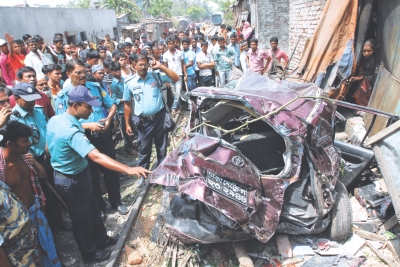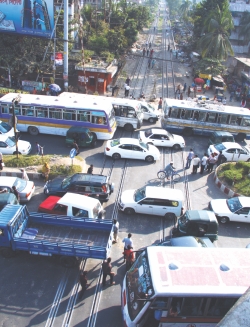| Home - Back Issues - The Team - Contact Us |
 |
| Volume 11 |Issue 20| May 18, 2012 | |
|
|
Special Feature On the Death Track The year 2012 has already witnessed 80 people killed due to train-related accidents. With a large number of railway crossings in the country left unguarded, the figure is bound to increase. the Star looks at the reasons behind the appalling statistic. Naimul Karim
It was supposed to be a day out for Sultan Ahmed and his family. The weekend was around the corner and Ahmed, along with his 70-year-old mother, sisters and nephews were looking forward to a happy outing. Travelling in a hired van, locally known as the 'Bhatbati', the family had no idea of the danger that awaited them. As fate would have it, a deadly collision between their vehicle and the 'Ekota Express', at an unmanned railway crossing in Natore, killed all six of them. What was meant to be a joyous family gathering, turned out to be a devastating tragedy. Train-related accidents lead to a large number of deaths in the country every year. The last five months, for instance, saw at least 80 people get killed due to various rail accidents, a large number of which occurred at unguarded railway level crossings. In fact, the very same crossing at Natore, which killed Ahmed and his family in March this year, was witness to similar accidents before. Several other accidents at rail-road junctions have been recorded this year. In February, a union parishad chairman and secretary were killed as they were passing the unmanned level crossing near the Nandangacchi Railway Station in Charghat. The same month saw the death of a 25-year-old expatriate, Razib Khan, as he tried going past the Habla track in Basail – another crossing without a gateman – on his motorbike. A recent report published in The Daily Star states that approximately 150 of the 242 level crossings under the West Zone of Bangladesh Railway are running without gatemen. It further states that a majority of the gatemen are employed on a temporary basis by the Bangladeshi Railway. "There are approximately 2,500 crossings in the country. It's not possible to keep a gateman or build a rail gate for each one of them," says Md Mozammel Haque, Chief Engineer of the Bangladesh Railway. "We aren't informed about a large number of roads built by the Roads and Highway Department (RHD). We have written several letters to them regarding rail gates and gatemen, but unfortunately there is a communication gap," he adds. Explaining the process of appointing a gateman at a new crossing, Former Chief Engineer, Bangladesh Railway (West Zone), Mohammad Amjad Hossain says, "After the RHD makes a road, it is their duty to come to us and pay us the required amount of money for building a rail gate and appointing an officer. However, that doesn't happen because nobody follows the law." The lack of cooperation between government agencies has created a large number of unmanned level crossings, thereby increasing the risk of accidents. One of the most prominent ones took place in 2006, when a train-bus collision, at the 'Amtra rail crossing' in Akelpur, Joypurhat, killed 35 people and left many others injured. Despite the devastating accident, the crossing is still devoid of any rail gate.
Speaking to the Star, Azizur Rahman, the Executive Engineer, RHD of Akelpur explains the institutional problems present within the department, "After the accident, the Railway Authorities gave us a proposal which enlisted the costs of building a rail gate and appointing a person. It was in lakhs. I forwarded the proposal to higher authorities and I am waiting for their response." When asked how long it would take for the funding to arrive, he replied that he had no idea. Another crossing prone to rail accidents, located in Sala, Tangail, saw two men killed by a Dhaka-bound train in January this year. The very same track saw three accidents last year, killing seven people in total. Despite being a constant threat, authorities have chosen to ignore the dangers at the crossing. Blaming the city corporation for its mismanagement, Dr. Sarwar Jahan, professor, Department of Urban and Regional Planning, BUET, is of the opinion that the rail accidents have stemmed from a governance problem. "Dhaka is the worst planned city in the world. Other countries have a huge separation between their rail lines and roads. The only way we can follow suit is by building over-bridges," says Dr Jahan, who adds that such steps should have been taken two to three decades ago. Various political factors have also played its role in enhancing such disasters. An accident at the Gandaria Crossing, in the capital, killed one person and injured five others, in March this year, as a train from Narayanganj rammed into a passing car. Considered as a risky level crossing, the Gandaria track and several others were closed down in February 2011, following a deadly collision in the area, which killed several people. However, people living in the region claim that the crossing, along with several other dangerous crossings were re-opened this year through political influence. Newly appointed Railway Minister, Obaidul Quader, states that there are much more pressing concerns that need his attention. "I have just been appointed the rail minister and currently I am concentrating on the most immediate concerns. My aims are to make the trains more punctual and to stop black marketing. The problem regarding the accidents will be solved in due time. I can't magically change everything in such a short period," he says. Amjad Hossain is of the opinion that the death toll related to train accidents can be reduced if people become more cautious while crossing rail tracks. "We have set up sign boards indicating the presence of rail tracks at almost every crossing. Even if there is no rail gate, a person should use his judgement while crossing a track." Apart from level crossings, a number of people die every month, most of whom are slum dwellers living next to rail tracks, while travelling on the roof-tops of trains or while walking on the rail bridges and tracks. While taking measures against these activities may be complicated, one can't help but wonder why the government doesn't enforce the building of secured level-crossings – a step that can decrease the number of killings by a huge margin. Statements made by concerned government officials suggest that authorities prefer playing the blame game rather than solving the problem. Statements such as 'We've put up signboards' or 'The rail proposal is awaiting acceptance from higher authorities' have been constantly used in media conferences. The application phase of it, however, never seems to arrive.
|
||||||||||||
Copyright
(R) thedailystar.net 2012 |


